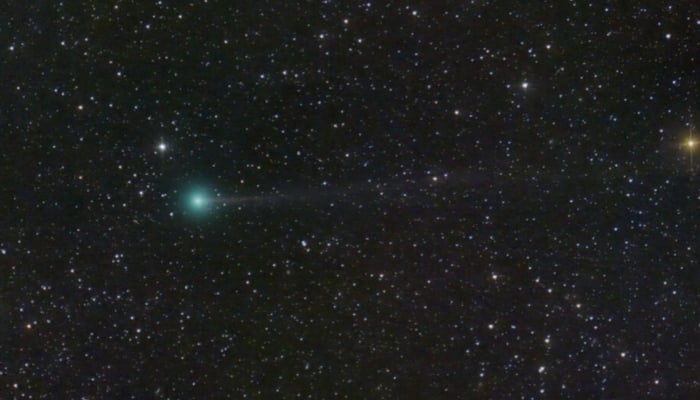Comet Nishimura: How can you catch sight of this rare celestial beauty this weekend?
Since its discovery, the comet has steadily grown brighter as it journeys through the inner solar system in its orbit around the sun.
September 09, 2023

A recently discovered comet, named Comet Nishimura after its observer, Japanese space photographer Hideo Nishimura, is set to make an appearance as it passes by Earth in the coming week.
However, spotting this celestial visitor may require some expertise.
Comet Nishimura was initially sighted by Hideo Nishimura in early August while he was capturing images of the night sky, as reported by EarthSky. Since its discovery, the comet has steadily grown brighter as it journeys through the inner solar system in its orbit around the sun.
On Tuesday, the comet will make its closest approach to Earth, coming within a distance of 78 million miles (125 million kilometres).
This proximity means that the comet could potentially be visible over the next five days. Subsequently, it will move closer to the sun, passing within 21 million miles (almost 34 million kilometres) of the star on September 17, according to Alan Hale, co-discoverer of Comet Hale-Bopp and founder and president of the Earthrise Institute.
Comet Nishimura completes a single orbit roughly every 430 to 440 years. The last time it passed close to the Sun, and potentially nearer to Earth, was believed to be around the year 1590, prior to the invention of telescopes.
Dr Paul Chodas, director of NASA's Center for Near Earth Object Studies at the Jet Propulsion Laboratory in Pasadena, California, noted, "We don't know whether it got bright enough to be seen with the naked eye back then."
Though no recorded comets from that era seem to correspond with Comet Nishimura, it would have had to be exceptionally bright to be visible, as suggested by Hale.
For those eager to catch a glimpse of Comet Nishimura, it's important to note that its faint brightness and proximity to the horizon make binoculars the recommended tool for observation. Optimal viewing conditions are found in dark, rural areas far from the glare of city lights.
Sky and Telescope magazine has provided charts to assist sky-watchers in locating the comet.
To distinguish it from other celestial objects, remember that the comet's tail always points away from the sun, due to the continuous push of sunlight on fine dust particles, as explained by Dave Schleicher, an astronomer at Lowell Observatory in Arizona.
Although the comet may appear greenish in photos due to the presence of diatomic carbon, through binoculars, it will likely appear nearly colourless or slightly pink as sunlight reflects off dust grains smaller than particles in talcum powder, according to Schleicher.
For viewers in the Northern Hemisphere, Dr Chodas recommends finding a clear view of the east-northeast horizon approximately half an hour before morning twilight.
You can use Time and Date to determine the timing of morning twilight, also known as civil twilight, in your specific location.
As the comet gets closer to the sun and the horizon, it becomes increasingly challenging to observe.
On Wednesday, the comet will pass between Earth and the sun, making it even more challenging to spot. Unless it significantly brightens beyond expectations, it will likely remain obscured by bright twilight.
Regarding Comet Nishimura's fate, the intense heat as it passes near the sun could potentially lead to its disintegration.
Dr Chodas explained, "As the frozen ices heat up and sublimate into gases, the comet may break up."
However, its survival is uncertain and depends on the size of the comet's nucleus, which is currently concealed by the surrounding coma—an atmosphere of gas and dust.
Nonetheless, considering the comet has endured at least one previous close encounter with the sun and likely many more (although its age is unknown), experts like Hale expect it to survive.
Hale added that if it does survive its sun passage, it will reappear on the far side of the sun from Earth in early October, becoming visible in the Southern Hemisphere's morning sky in November.
Its visibility may persist for several months, albeit as a relatively dim object that fades gradually as it moves away from the sun and Earth.
After this encounter, over 400 years will pass before Comet Nishimura approaches Earth again.
If you happen to miss the opportunity to witness Comet Nishimura, there are several other comets expected to grace the night sky in the next 16 months, as noted by Hale.
Comet Pons-Brooks will reach its closest point to the sun in April and should be faintly visible to the naked eye in the evening sky for approximately a month beforehand.
In June, Comet Olbers will closely approach the sun, becoming visible with binoculars.
Finally, Comet Tsuchinshan-ATLAS, discovered in January, will come closest to the sun in late September 2024 and will pass by Earth in mid-October 2024, with the potential to become exceptionally bright.









